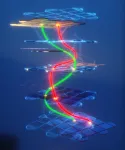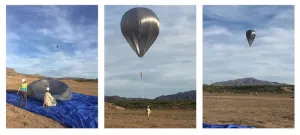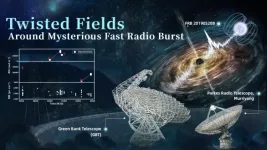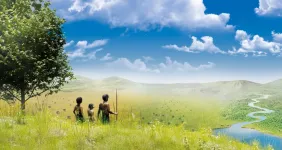(Press-News.org) Our intuition tells us that it should be impossible to see whether two identical objects have been swapped back and forth, and for all particles observed to date, that has been the case. Until now.
Non-Abelian anyons - the only particles that have been predicted to break this rule - have been sought for their fascinating features and their potential to revolutionize quantum computing by making the operations more robust to noise. Microsoft and others have chosen this approach for their quantum computing effort. But after decades of efforts by researchers in the field, observing non-Abelian anyons and their strange behavior has proven challenging, to say the least.
In a paper posted on the preprint server Arxiv.org last October and published in Nature today, researchers at Google Quantum AI announced that they had used one of their superconducting quantum processors to observe the peculiar behavior of non-Abelian anyons for the first time ever. They also demonstrated how this phenomenon could be used to perform quantum computations. Earlier this week the quantum computing company Quantinuum released another study on the topic, complementing Google’s initial discovery. These new results open a new path toward topological quantum computation, in which operations are achieved by winding non-Abelian anyons around each other like strings in a braid.
Google Quantum AI team member and first author of the manuscript, Trond I. Andersen says, “Observing the bizarre behavior of non-Abelian anyons for the first time really highlights the type of exciting phenomena we can now access with quantum computers.”
Imagine you’re shown two identical objects and then asked to close your eyes. Open them again, and you see the same two objects. How can you determine if they have been swapped? Intuition says that if the objects are truly identical, there is no way to tell.
Quantum mechanics supports this intuition, but only in our familiar three-dimensional world. If the identical objects are restricted to only move in a two-dimensional plane, sometimes, our intuition can fail and quantum mechanics allows for something bizarre: non-Abelian anyons retain a sort of memory — it is possible to tell when two of them have been exchanged, despite being completely identical.
This “memory” of the non-Abelian anyons can be thought of as a continuous line in space-time: the particle’s so-called “world-line.” When two non-Abelian anyons are exchanged, their world-lines wrap around one another. Wrap them in the right way, and the resulting knots and braids form the basic operations of a topological quantum computer.
The team started by preparing their superconducting qubits in an entangled quantum state that is well represented as a checkerboard — a familiar configuration for the Google team, who recently demonstrated a milestone in quantum error correction using this setup. In the checkerboard arrangement, related — but less useful — particles called Abelian anyons can emerge.
To realize non-Abelian anyons, the researchers stretched and squashed the quantum state of their qubits to transform the checkered pattern into oddly shaped polygons. Particular vertices in these polygons hosted the non-Abelian anyons. Using a protocol developed by Eun-Ah Kim at Cornell University and former postdoc Yuri Lensky, the team could then move the non-Abelian anyons around by continuing to deform the lattice and shifting the locations of the non-Abelian vertices.
In a series of experiments, the researchers at Google observed the behavior of these non-Abelian anyons and how they interacted with the more mundane Abelian anyons. Weaving the two types of particles around one another yielded bizarre phenomena — particles mysteriously disappeared, reappeared and shapeshifted from one type to another as they wound around one another and collided. Most importantly, the team observed the hallmark of non-Abelian anyons: when two of them were swapped, it caused a measurable change in the quantum state of their system — a striking phenomenon that had never been observed before.
Finally, the team demonstrated how braiding of non-Abelian anyons might be used in quantum computations. By braiding several non-Abelian anyons together, they were able to create a well-known quantum entangled state called the Greenberger-Horne-Zeilinger (GHZ) state.
The physics of non-Abelian particles is also at the core of the approach that Microsoft has chosen for their quantum computing effort. While they are attempting to engineer material systems that intrinsically host these anyons, the Google team has now shown that the same type of physics can be realized on their superconducting processors.
This week the quantum computing company Quantinuum released an impressive complementary study that also demonstrated non-Abelian braiding, in this case using a trapped-ion quantum processor. Andersen is excited to see other quantum computing groups observing non-Abelian braiding as well. He says, “It will be very interesting to see how non-Abelian anyons are employed in quantum computing in the future, and whether their peculiar behavior can hold the key to fault-tolerant topological quantum computing.”
END
Google Quantum AI braids non-Abelian anyons for the first time
2023-05-11
ELSE PRESS RELEASES FROM THIS DATE:
Solar-powered balloons detect mysterious sounds in the stratosphere #ASA184
2023-05-11
CHICAGO, May 11, 2023 – Imagine if sending your science experiment 70,000 ft in the air just took painter’s plastic, tape, a dash of charcoal dust, and plenty of sunlight.
Daniel Bowman of Sandia National Laboratories will present his findings using solar-powered hot air balloons to eavesdrop on stratospheric sounds at the upcoming 184th Meeting of the Acoustical Society of America, running May 8-12 at the Chicago Marriott Downtown Magnificent Mile Hotel. His presentation will take place Thursday, May 11, at 2:50 p.m. Eastern U.S. in the Purdue/Wisconsin ...
Earth system modeling and fossil data reveal Homo adaptation to diverse environments
2023-05-11
Homo species – particularly Homo sapiens – were uniquely equipped to adapt to highly diverse environmental conditions and landscape mosaics, according to a new study, which may have enabled our species and that of our closely related ancestors to survive and thrive in highly fluctuating Pleistocene environments. Homo sapiens are the only surviving hominin species today. However, whether this is because our species was uniquely successful at adapting to Pleistocene environments, because we outcompeted other contemporary Homo species through unique physiological or social adaptations, ...
A better route to benzocyclobutenes, sought-after buildingblocks for drugs
2023-05-11
LA JOLLA, CA— Scripps Research chemists have solved a long-standing problem in the field of pharmaceutical chemistry with a relatively simple and controllable method for making benzocyclobutenes (BCBs)—a class of reactive compounds that are highly valued as building blocks for drug molecules, but have been relatively hard to access.
The new method, described in a paper in Science on May 12, uses designer ligand molecules with palladium-atom catalysts to break pairs of adjacent methylene-type C-H bonds in relatively cheap and abundant carboxylic acids. Breaking these bonds enables the making ...
Researchers discover twisted fields around mysterious fast radio burst
2023-05-11
Fast Radio Bursts (FRBs) are the brightest millisecond-duration cosmic explosions in radio bands. Their unknown origin poses challenges for astronomy as well as physics.
The Commensal Radio Astronomy FAST Survey (CRAFTS), a key program of the Five-hundred-meter Spherical radio Telescope (FAST), discovered the world's first persistently active repeating FRB, known as FRB 20190520B. Now this FRB has provided clues that may help clarify the origin of FRBs.
An international team led by Dr. LI Di from the National Astronomical Observatories of the Chinese Academy of Sciences (NAOC) carried out a monitoring campaign of FRB 20190520B, using the Parkes telescope in Australia and ...
U.S. Fishing Policy is Boosting Fish Populations, Not Constraining Most Fisheries
2023-05-11
Commercial fishing employs 1.2 million Americans and generates more than $165 billion annually. Yet warming waters are threatening fish populations and disrupting fisheries around the world—a challenge set to worsen as climate change advances. Despite the importance of sustaining fisheries, the reauthorization of the cornerstone policy protecting them in the United States—the Magnuson-Stevens Act—has been stalled in Congress for a decade. The holdup? Some blame the policy for being too stringent and leading to what they call “underfishing,” while others ...
Human ancestors preferred mosaic landscapes and high ecosystem diversity
2023-05-11
A new study published in the journal Science by an international team finds that early human species adapted to mosaic landscapes and diverse food resources, which would have increased our ancestor’s resilience to past shifts in climate.
Our genus Homo evolved over the past 3 million years – a period of increasing warm/cold climate fluctuations. How early human species have adapted to the intensification of climate extremes, ice ages, and large-scale shifts in landscapes and vegetation remains elusive. ...
Hammerhead sharks hold their breath on deep water hunts to stay warm
2023-05-11
Scalloped hammerhead sharks hold their breath to keep their bodies warm during deep dives into cold water where they hunt prey such as deep sea squids. This discovery, published today in Science by University of Hawai‘i at Mānoa researchers, provides important new insights into the physiology and ecology of a species that serves as an important link between the deep and shallow water habitats.
“This was a complete surprise!” said Mark Royer, lead author and researcher with the Shark Research Group at the Hawai‘i Institute of Marine Biology (HIMB) in the UH Mānoa School of ...
The feeling of hunger itself may slow aging in flies
2023-05-11
From low-carb to intermittent fasting, surgery to Ozempic—people turn to a seemingly never-ending array of diets, procedures and drugs to lose weight. While it has been long understood that limiting the amount of food eaten can promote healthy aging in a wide range of animals, including humans, a new study from University of Michigan has revealed that the feeling of hunger itself may be enough to slow aging.
Previous research has demonstrated that even the taste and smell of food can reverse the beneficial, life-extending effects of diet restriction, even without its consumption.
These intriguing findings drove first author Kristy Weaver, Ph.D., principal investigator ...
Nature is changing as land abandonment increases
2023-05-11
When people leave their rural lives behind to seek their fortunes in the city or agriculture is no longer profitable, the lands they toiled on are often left unused. A new perspective piece in Science shows that these abandoned lands could be both an opportunity and a threat for biodiversity, and highlights why abandoned lands are critical in the assessment of global restoration and conservation targets.
The past 50 years have seen an increased exodus of populations from rural to urban areas. Today, 55% ...
First-of-its-kind measurement of the Universe’s expansion rate weighs in on a longstanding debate in physics and astronomy
2023-05-11
Thanks to data from a magnified, multiply imaged supernova, a team led by University of Minnesota Twin Cities researchers has successfully used a first-of-its-kind technique to measure the expansion rate of the Universe. Their data provide insight into a longstanding debate in the field and could help scientists more accurately determine the Universe’s age and better understand the cosmos.
The work is divided into two papers, respectively published in Science, one of the world’s top peer-reviewed academic journals, and The Astrophysical Journal, a peer-reviewed scientific journal of astrophysics and astronomy.
In astronomy, there are two precise ...






